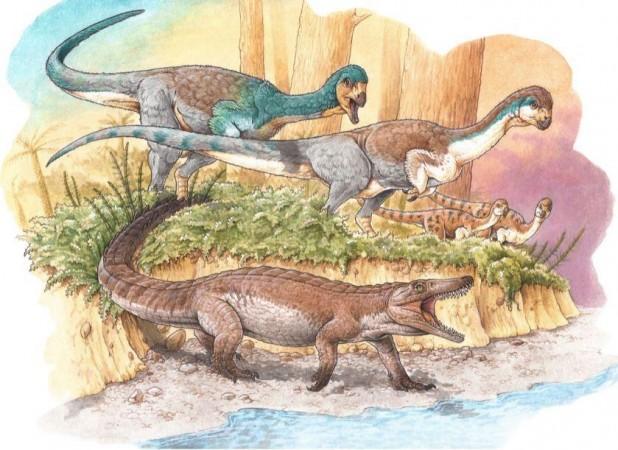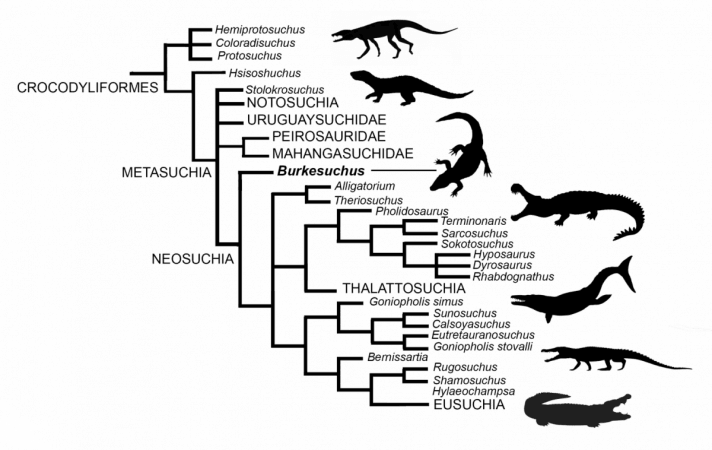Crocodiles are among the few creatures on this planet that predate human beings by millions of years. Right from walking among dinosaurs to lurking in waters around human beings, they have persisted for aeons.
However, these reptiles have a long evolutionary history with several of them going extinct as the family marches forward. Now, scientists have discovered the 150-million-year-old fossilized remains of a crocodilian in Chile that they state is the 'grandfather' of modern-day crocodiles.
According to the international study, the new species—Burkesuchus mallingrandensis—was a land-dwelling crocodile that existed alongside dinosaurs approximately 148 million years ago. Found in the mountains of the Aysén region in southern Chile, the specimen is said to be closely related to the common ancestor of modern crocodiles, making the scientists dub it their 'grandfather'.
"Burkesuchus tells us about the origins of modern crocodiles and how, 150 million years ago, they began to modify their anatomy, adopting an amphibian way of life," said Dr. Federico Agnolin, corresponding author of the study, in a statement. The study was published in the journal Nature Scientific Reports.
Persisting for Millions of Years

Crocodiles emerged around the same time as the very first dinosaurs at the beginning of the Jurassic Period (199.6 million to 145.5 million years ago). In a matter of only a few million years, they took to marine life and evolved into formidable predators of aquatic creatures such as fish. With seas being shallow and warm during the period, they served as pathways or highways for aquatic crocodiles to spread across the planet.
The continent of South America is rich with fossils of large marine crocodiles. However, not much is known about the crocodiles that lived on land in the area, or across the world. "The land-dwelling Jurassic crocodiles were no larger than the size of a domestic cat and, unlike their fearsome marine cousins, their diet was based on small invertebrates. We knew nothing in South America about those tiny crocodiles that inhabit puddles and lagoons, until we found the remains of Burkesuchus," averred Dr. Fernando Novas, co-author of the study.
Finding a New Species

In 2014, the team discovered the unknown species in the town of Mallin Grande in the Patagonia Mountain Range that stretches across Argentina and Chile. It was christened Burkesuchus mallingrandensis in honor of Late Coleman Burke, a passionate paleontology enthusiast from the US. Burke was known for his patronage for paleontological explorations, including the one that led to the discovery of this crocodilian ancestor.
The rocks of the Toqui Formation—a geological formation in the heart of the Patagonia Mountain Range—are considered to be a bountiful site of a completely new fauna of Jurassic reptiles. As the researchers stumbled upon the fossil, they hoped that it would be a novel species and not a known dinosaur found in the region such as Chilesaurus. "Now, several years later, at last, the crocodile comes to light and shines by itself, further illuminating the knowledge of the fauna of the late Jurassic," expressed Dr. Rita de la Cruz, co-author of the study.

Following its discovery, the fossilized remains were kept and studied at the Museum of Buenos Aires. Upon examining the skeleton in great detail, the structure of the skull and hind legs revealed that the Burkesuchus held a crucial place in the evolutionary history of crocodiles.
'Grandfather' of Modern Crocodiles

According to the team, Burkesuchus was not more than 70 centimeters in length. It moved on all fours, with an intermediate posture somewhere between the vertical of crocodile ancestors and that of the existing crocodiles. Its tail, back, and neck were covered by protective bone plates in double row, superimposed like tiles in a roof.
"Despite the fact that its jaws and teeth have not been preserved, Burkesuchus' kinship relationships lead us to suppose that it was a predator of small animals, probably invertebrates, that it would capture on the shores of the lagoons where it lived," noted Dr. Fernando Novas, co-author of the study.

Upon further analysis of the skull's structure, it was revealed that much like its living relatives, Burkesuchus possessed a fleshy flap—which when closed—that protected the creature's ears as it submerged itself in water. The ancient species is said to be closely related to the common ancestor of 'new crocodiles' (belonging to a clade called Neosuchia).
"Burkesuchus tells us about the origins of modern crocodiles and how, 150 million years ago, they began to modify their anatomy, adopting an amphibian way of life," concluded Dr. Agnolín.











